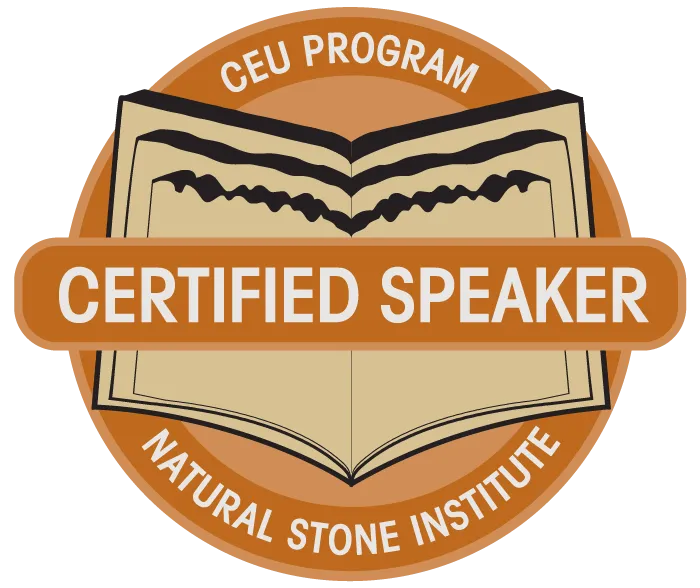Continuing Education Unit (CEU)
CEU COURSES
Marble Unlimited is thrilled to present our latest NSI CEU courses, designed to enhance your professional skills and knowledge. Discover our diverse offerings and take the next step in your career development with our expertly crafted programs.

Our Courses
Achieving Green Building Goals with Natural Stone
Natural stone is nearly complete as a building material in its natural state and has proven its durability over the centuries. Combine these attributes with knowledge that the industry has committed to lowering impacts, being socially responsible, and aligning with green building programs. Most design teams already agree that natural stone is inherently a great solution for projects with green building goals. This session will elaborate on why and show you where to find the documentation needed to check more boxes than you might have realized were possible with natural stone.
Natural Stone Principles
This one-hour course is your introduction to using natural stone as a building material. By reviewing the fundamentals of its formation and mineral composition, you will gain confidence in specifying this versatile material. Let us open your eyes to the endless possibilities for these beautiful, durable and valued natural stones.
Natural Stone vs. Manmade Materials: Exterior Applications
Natural stone has been the premier building material of choice throughout history, thanks to its durability and timeless aesthetic. Inherently beautiful and versatile, it’s no wonder that manmade materials aim to replicate its attributes, appearance and ultimately its desirability. This course will compare the versatility, performance characteristics, and green building considerations for both natural stone and manmade materials. Understanding these key points will prepare you with knowledge for design concepts, applications and how to educate the consumer. Styles change from season to season, but mother nature creates unique designs in natural stone that are historically innovative and always on trend.
Natural Stone vs. Manmade Materials: Interior Applications
Natural stone has been the premier building material of choice throughout history, thanks to its durability and timeless aesthetic. Inherently beautiful and versatile, it’s no wonder that manmade materials aim to replicate its attributes, appearance and ultimately its desirability. This course will compare the versatility, performance characteristics, and green building considerations for both natural stone and manmade materials. Understanding these key points will prepare you with knowledge for design concepts, applications and how to educate the consumer. Styles change from season to season, but mother nature creates unique designs in natural stone that are historically innovative and always on trend.
Art of Specifying Natural Stone
This one hour session is designed to give architects and designers an overview of how to specify natural stone. There are many factors to consider to ensure you are choosing the proper material for your project. What do you need to know about its species, color variations, and finish possibilities? Is the quarry able to produce the sizes and quantities you need? And finally, what factors affect the price of the stone you specify? Get the resources you need to help ensure the stone you choose meets the standards and design intent set for your application.
Natural Stone Embodied Carbon Research
Join the Natural Stone Institute and member companies to review recent embodied carbon research. This includes learning about Industry-Wide Environmental Product Declarations (EPDs) that cover stone flooring, cladding, and countertops. These EPDs showcase natural stone’s low embodied carbon compared to manmade materials. Attendees will walk away with identifiable ways to reduce embodied carbon in future projects including identifying ways of incorporating natural stone into their projects.
Why Specify Certified Stone
This course highlights how the dimension stone sustainability standard (ANSI/NSC 373) can assist projects with sustainability goals. The standard examines and verifies through a third party, numerous areas of stone production such as: water usage, custody and transportation, site and plant management, land reclamation, corporate governance, energy, waste, chemicals, worker health and safety and innovation credits. It also includes a companion Chain of Custody (COC) program, which ensures traceability of certified stone from the quarry to processing and throughout the supply chain and ultimately to their journeys end.
Natural Stone and Green Design
This one-hour presentation is intended to explain how natural stone fits into the Green movement. The stone industry continues to reduce environmental impacts through technology advancements and responsible manufacturing and shipping processes. We will discuss historical uses of natural stone that have stood the test of time. You will see examples of how key characteristics of stone such as its life cycle and carbon footprint satisfy elements of green building standards.
Natural Stone Countertops: Considerations for Kitchen and Bath Applications
Natural Stone Countertops: Considerations for Kitchen and Bath Applications. Natural stone applications can add beauty, character, and value to any living space. By communicating the proper expectations for performance and maintenance requirements, the consumer will gain a better understanding and appreciation for using natural stone in their kitchens and bathrooms.
Why Choose Natural Stone?
With so many building materials on the market today, this course will remind you why architects and designers keep choosing natural stone for their projects. Throughout history we’ve seen natural stone used in iconic structures symbolizing strength and permanence. New materials strive to mimic its beauty, but genuine natural materials connect us with our planet and its future in a unique and undeniable way. Its inherent durability allows stone to perform impeccably in commercial and residential applications, interior or exterior. New technologies are also keeping stone a front runner with innovative interior design trends by introducing new textures and patterns.
Introduction to Stone Design II
This one-hour class is designed for architects, landscape architects, and interior designers desiring to gain a full understanding of natural stone as a building material. Attendees will better understand stone testing requirements needed for some residential, commercial, interior and exterior applications. They will also learn about many common applications of natural stone including walking surfaces, vertical surfaces, furniture and countertops.
There’s Something About Quartzite
Quartzite is a beautiful building material. With that beauty comes unique fabrication and installation techniques. Join the Natural Stone Institute and Stone World magazine as we discuss the world of geological quartzite. During the session, we will discuss the geology, fabrication, and installation practices that provide the best product application of this material. We will also review how to set expectations with customers to ensure successful installation and a happy client. Come away with a plan to maximize the value of quartzite to both your company and the customer.
Sandstone as a building material
This session, presented by Natural Stone Institute, was created for design professionals to gain a better understanding of sandstone as a building material. Learn more about how to select this natural stone for a variety of interior and exterior applications. Gain an understanding of how sandstone is produced and fabricated and its unique application opportunities to enhance your design plans and obtain information about setting the proper consumer expectations in regards to installation and maintenance.
Celebrate Natural Stone
Celebrate Natural Stone is a one-hour educational experience that will bring the presenter and audience together in an open environment to explore and appreciate the historic origins, durability and inherent beauty of natural stone. This experience will also demonstrate the versatility of natural stone as a building material by showcasing different applications, creations or stone samples. This course provides an opportunity to connect with one another outdoors and visualize natural stone in the built environment. A sustainable, recyclable building material created by nature is certainly something to celebrate.
Wine & Stone
Red or white, sweet or dry? The Wine & Stone presentation was developed as a unique way to show attendees what factors make stone hard or soft, veined or patterned, etc. For example, nutritionally restricted limestone soil gives more acidity to the wines grown there. Mineral composition also comes into play when talking about the characteristics of stone. Marbles are composed primarily of calcium carbonate which makes them less resistant to chemicals such as acids and bases. Find out more interesting facts that determine the characteristics of wine & stone!
WANT TO LEARN MORE?
At Marble Unlimited, our Lunch and Learn sessions offer a dynamic and engaging way to enhance your team's professional development. We understand that every firm has unique needs, which is why we tailor each session to fit your specific priorities. Enjoy a complimentary lunch while your team benefits from a customized educational experience designed to foster growth and expertise. Make the most of this valuable opportunity to invest in your team's future!








